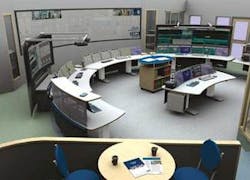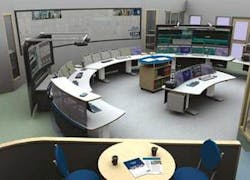CONTROL ROOMS: Norwegian operators leading drive for improved operational overview, comfort
Oil industry interest is increasing in CGM’s ergonomic control room and process presentation solutions, which can improve the efficiency of control operations. Eventually, regulatory requirements will have to be adjusted to reflect the latest developments, according to the company’s international sales manager Pierre Schäring.
In Norway, oil companies appreciate the benefits of a control room environment incorporating close large overview (CLOV) screens that present round-the-clock status of process operations. These are combined with furniture specially designed to meet operators’ needs to stay alert and focused.
Statoil uses the company’s operator desk in a new control room associated with the Troll A Compression project. It has since placed further orders for the Statfjord A, B, and C platforms, which are undergoing major upgrades as part of the Statfjord Late Life project. In this case, CGM is a sub-supplier to Bjørge Norcoat, the modifications contractor.
The Swedish company is also supplying a tailor-made operator desk for the control room and a collaboration room at Norsk Hydro/Shell’s Ormen Lange process terminal at Nyhamna on the coast of mid-Norway. Under sub-contract to Vetco Aibel, CGM is supplying equipment to Maersk Contractors for Statoil’s new Volve jackup production platform, and to Marathon for theAlvheim FPSO. The company has also been in talks to supply other upcoming projects in the Norwegian sector.
Elsewhere, ExxonMobil, is interested in using the CLOV technology in conjunction with ABB’s 800xA automation system for a control room upgrade on the Hibernia platform off eastern Canada. ABB indicated it would place an order for operator desks and CLOV equipment for this project.
“We know all the details about the technology,” says Schäring, “whereas the automation system supplier doesn’t; so we like to have the opportunity to explain directly to the end-customer what we can supply.”
A few years ago, he adds, control room thinking centered round the traditional console. Now there is a lot more function in control operations, and CGM is experiencing increasing demand from the end-customer for a comfortable working environment for the operators.
Space-saving combination
However, regulatory requirements are lagging well behind current thinking. The relevant ISO standard, ISO 11064, sets out how control rooms in process plants should be organized, and Part 4 makes numerous recommendations, such as that the height of furniture should be adjustable. But many customers only pay attention to requirements, ignoring recommendations, Schäring says.
The Norsok regulations which are applied in Norwegian offshore projects contain requirements for the adjustability of operator desks, but not for their stability in the highest position, nor for their motorized speed or quality. TCO, a Swedish white collar trade union which acts as an informal standards agency for office furniture, has taken some of these issues to the responsible bodies, which may lead to an update in the regulations.
Collaboration rooms for emergency response operations increasingly are being included in the planning for new control rooms. In response to this, CGM has designed a collaboration desk. Under normal conditions it functions as a conference desk, but it can be converted easily into emergency mode, providing access to communication equipment hidden in the interior.
CGM’s ergonomic approach to the design of control room furniture recognizes that the operators need to remain alert while monitoring the process plant, as they spend long periods in sedentary positions. The height of the operator desk - the main product in the company’s Cergo range of control room furniture - can be adjusted by motors from 65-130 cm (26-51 in.). This gives operators the choice of standing up while they work, as well as sitting down. The modular design of the furniture ensures ease of adaptability to individual requirements.
In the CLOV projection technology which CGM has developed in partnership with 3D Perception, images from operators’ monitor screens are projected onto a large, domed screen from projectors mounted on the ceiling. Compared with cubes using back projection, this method takes up very little space.
The system has been developed with an emphasis on rapid response to critical situations, Schäring says. If an alarm sounds in one area, the image from the relevant CCTV camera is presented automatically, without the operators having to search through a bank of CCTV images. Because all the critical information can be presented simultaneously on the same screen, the time required for decision-making is reduced. ABB has integrated its 800xA system platform very well with this new way of working and is successfully marketing the complete system as the 800xA Extended Operator Workplace.
The Megawall, a wall-based screen using the same projection technology, allows the seamless integration of multiple computer and video sources, and can be viewed by all the operators.
Technology development continually opens new possibilities, Schäring says. For example, one keyboard today can work three screens, something that was not possible six months ago. Also, the use of fiber-optic cable allows a keyboard linked to a remote computer, saving space around the operator desk.
These developments have implications for the design of control rooms. “We need to be flexible, and adjust the design in response to customers’ demands,” says Schäring.
For more information contact Pierre Schäring, CGM. Tel +46 3322 9500, fax +46 3322 9510.[email protected], www.cgm.se

